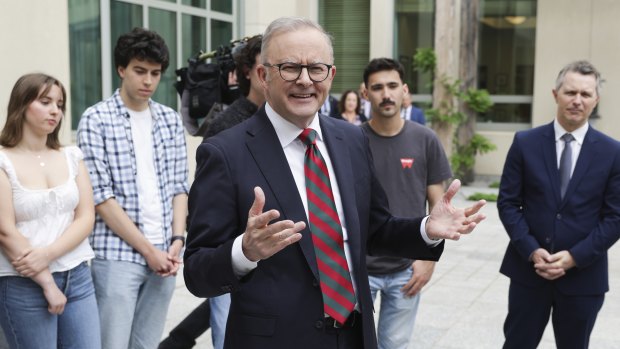Editorial
Sound policy with a dose of politics: Questions remain over student loan changes
It is to be expected that from now until the federal election every announcement, whether it be from Labor or the Coalition, will be viewed through the slot of the ballot box. And so it has occurred with the recent announcements from the Labor government on higher education. The race has begun.
At the weekend, Prime Minister Anthony Albanese unveiled higher education changes that will remove 20 per cent from the debt of 3 million people. The move will cut $5500 from an average student loan debt of about $27,000.

Prime Minister Anthony Albanese and Minister for Education Jason Clare meet with TAFE and university students, at Parliament House in Canberra on Monday.Credit: Alex Ellinghausen
The 20 per cent cut also applies to TAFE and apprenticeship loans.
Also, from next financial year, a graduate will not have to start repaying their HECS-HELP debt until they earn $67,000 a year. At present, the threshold is $54,435.
On top of that, Labor proposes a system in which, similar to the marginal tax system, the repayments are scaled so that higher rates apply only to income in each bracket rather than across a borrower’s entire earnings.
This flows from a recommendation from the Australian Universities Accord, a review commissioned by the Albanese government in 2022 into Australia’s higher education system.
The marginal repayment system will aid graduates in that although student loans are not linked to interest rates, they are to inflation. More than 50,000 people have debts above $100,000.
On Tuesday, Education Minister Jason Clare confirmed another tranche of the government’s education push: Labor would establish a commission to set the cost of university degrees.
At present, government sets the rate. The government says the moves are part of rolling back the Morrison government’s Job-ready Graduates program.
After the bruising encounter the prime minister endured in related to access to the Chairman’s Lounge and Qantas flight upgrades, it is clear Albanese has gone on the offensive over education.
The opposition has dismissed the announcements as merely the work of Albanese making “people like him again”.
It argues the proposals are unfair for the rest of the population – that is, a section of society is benefiting to the detriment of the rest – and calls the plan a “profoundly unfair policy”. “People who have the benefit of a tertiary education will have much higher lifetime earnings than the average across the community, and therefore it’s appropriate that they bear some of the cost of their education,” Liberal frontbencher Paul Fletcher told Radio National.
Then there are those who have toiled and paid off their loan already. The vice-chancellor of Western Sydney University, Professor George Williams, predicts they won’t be happy. The 20 per cent cut applies only to debts that exist on June 1 next year.
As the government hits the election hustings to sell its policy of slashing student debt, it will need to do more to adequately address the fairness question – from the perspective of those who have already paid of their debt, those who didn’t benefit from a university or TAFE education, and future students.
The government, however, can lean into other elements of the policy that are more difficult to fault at a time when Australians are facing cost-of-living pressures.
Economist Chris Richardson, who also noted the fairness question with reducing debts in an opinion piece in this masthead, said that allowing graduates to earn more before they had to start repaying their student loans and “sensibly” trimming the pace at which they had to repay was “good policy” – and smart politics.
The cost of an education has been a thorny political issue for decades. Gough Whitlam abolished university fees in 1974, thereby opening up higher education to thousands for whom the gates had always been locked.
At the end of the 1980s, Labor, under the prime ministership of Bob Hawke, introduced HECS as part of a major education restructuring. The Morrison government introduced the Job-ready program, which was designed to shift young people to courses where there were critical jobs shortages. Critics saw the move as ideological driven.
Professor Bruce Chapman, known as the architect of HECS, told the ABC: “The right way to charge HECS is the expectation of future lifetime incomes, and that’s why people studying law or medical specialties should be charged the most and people studying humanities should be charged the least. We don’t have that at the moment.”
Undoubtedly, the HELP system was due for renovation. Young people confronted with a housing crisis in particular have been saddled with unnecessarily steep debts, only making their challenges harder.
There is also a benefit to society from a thriving tertiary sector producing quality graduates. We should hope we don’t deter some of the best and brightest through penny-pinching.
To that end, the changes to indexation announced in the budget, the new marginal system and the review of course fees look sensible and measured. Stemming from the Universities Accord they also have sound policy foundations.
Meanwhile, the 20 per cent cut to loan balances, arguably the marquee part of the package, looks more like rank politics. Why the number was chosen, what other options were jettisoned and how it was formulated are not clear.
It will undoubtedly help, and be welcomed by, those with student debts, but just because a policy is welcomed does not excuse it from examination and explanation.
Education is fundamental to a nation, its wellbeing and its growth. It is too important to be hostage to political point-scoring.
Get a weekly wrap of views that will challenge, champion and inform your own. Sign up for our Opinion newsletter.